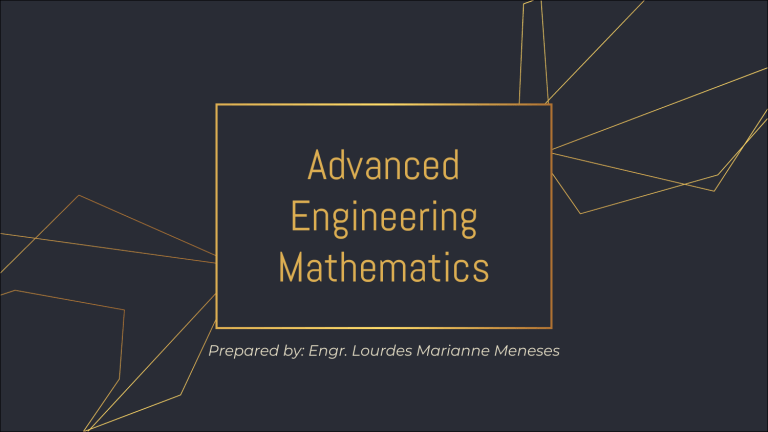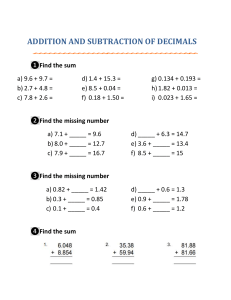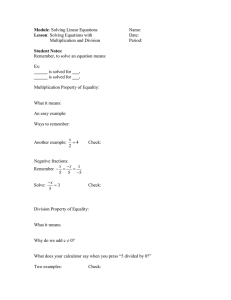
Advanced Engineering Mathematics Prepared by: Engr. Lourdes Marianne Meneses SOLVING LINEAR EQUATION Goal: The goal of solving a linear equation is to find the value of the variable that will make the statement (equation) true. Solving Linear Equation Method: Perform operations to both sides of the equation in order to isolate the variable. Addition and Subtraction Properties of Equality Let a, b, and c represent algebraic expressions. 1. Addition property of equality: If then a = b, a+c=b+c 2. Subtraction property of equality: If then a = b, a-c=b-c Solving Linear Equation Method: Perform operations to both sides of the equation in order to isolate the variable. Multiplication and Division Properties of Equality Let a, b, and c represent algebraic expressions. 3. Multiplication property of equality: a = b, ac = bc If then 4. Division property of equality: If then a = b, � = (provided c ≠0) � � � Solving Linear Equation Clearing Fractions or Decimals in an Equation When solving an equation with fractions or decimals, there is an option of clearing the fractions or decimals in order to create a simpler equation involving whole numbers. 1. To clear fractions, multiply both sides of the equation (distributing to all terms) by the LCD of all the fractions. 2. To clear decimals, multiply both sides of the equation (distributing to all terms) by the lowest power of 10 that will make all decimals whole numbers. Solving Linear Equation Steps for Solving a Linear Equation in One Variable: 1. Simplify both sides of the equation. 2. Use the addition or subtraction properties of equality to collect the variable terms on one side of the equation and the constant terms on the other. 3. Use the multiplication or division properties of equality to make the coefficient of the variable term equal to 1. 4. Check your answer by substituting your solution into the original equation. Note: If when solving an equation, the variables are eliminated to reveal a true statement such as, - 13 = - 13, then the solution is all real numbers. This type of equation is called an identity. On the other hand, if the variables are eliminated to reveal a false statement such as, - 7 = 3, then there is no solution. This type of equation is called a contradiction. All other linear equations which have only one solution are called conditional. EXAMPLES Check: (−7) + 5 = − 2 − 2 = − 2 (Solution Checks) A. � + 5 =− 2 -5 = -5 � = −7 Check: 10 − 3 = 7 7 = 7 (Solution Checks) B. � − 3 = 7 + 3 + 3 � = 10 C. 3� = 24 3� 3 D. = Check: 3(8) = 24 24 = 24 (Solution Checks) 24 3 � = 8 3 2 2 3 � = -4 ( x) = 2 3 −4 1 3 *2 � = −6 (Multiply by the reciprocal) Check: 2 −6 ( ) = -4 3 1 − 4 = − 4 (Solution Checks) EXAMPLES Identity Example: E. 10 − 5x = 3 (x − 4) − 2(x + 7) 10 − 5x = 3x − 12 − 2x − 14 10 − 5x = � − 26 -x = -x 10 − 6� = − 26 − 10 − 10 − 6� = − 36 −6� −36 = −6 −6 � = 6 Check: 10 − 5(6) = 3 (6 − 4) − 2(6 + 7) 10 − 30 = 3(2) − 2(7) −20 = 6 − 26 −20 =− 20 (Solution Checks) EXAMPLES Contradiction Example: F. 5x − 3 = 4 (x + 2) + x 5x − 3 = 4x + 8 + x 5x − 3 = 5� + 8 − 5� − 5� − 3 = 8 ����� ���������



